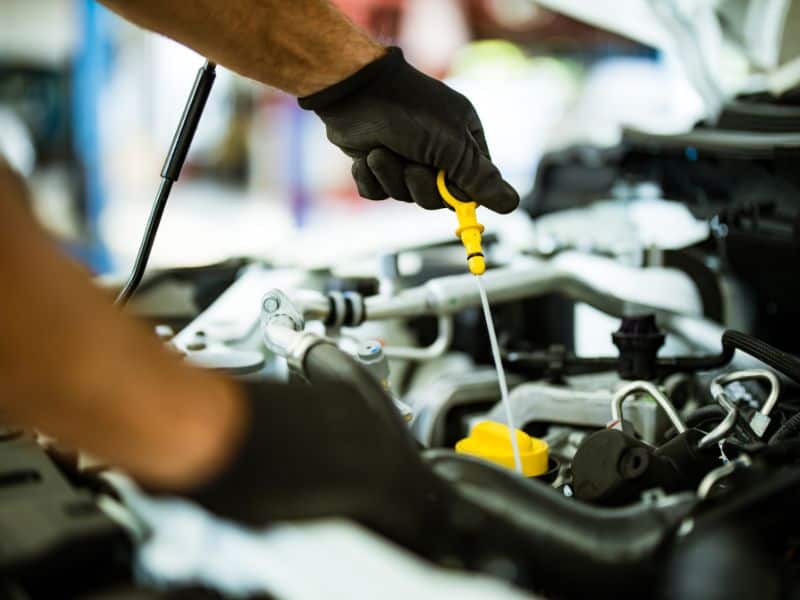There isn’t an average amount for all engines, but most small 4-cylinder engines can take up to 4 quarts, while big V8 machines closer to 8 quarts.
This isn’t a given, so instead, look inside your vehicle’s manual, ask at a mechanical shop, or constantly test the level by controlling the oil dipstick level if your car has one.
So let me provide you with the correct places where you can find how much oil your car needs.
How Much Oil Does My Car Need?
The average amount of oil a car can hold in the engine is between 4 to 8 quarts (3.8 to 7.6 liters).
There are dangers of overfilling and underfilling your vehicle with oil, so here are the four best ways to find how much oil your car needs:
4 ways to find out how much oil your car needs

1. Vehicle Manual
Inside every vehicle’s manual, you will find the total amount of oil needed for your car.
Usually, this will be listed under the maintenance/self-maintenance segment of the manual.
If your vehicle does not have a manual, you can easily ask for a new one at the dealership or even find it online and download or print it.
2. Contact a professional
If you are out of luck finding a user manual for your vehicle, write down your vehicle’s VIN and manufacturer name, and model and find a reputable dealership or mechanic shop.
The chances are high that they will carry all the necessary information for your vehicle, including how much oil it needs.
3. Online forums/groups
If you can’t find a dealership or mechanic workshop near you, don’t fear, for the internet has made looking up information easily.
If you have a rare or unique car where options 1 and 2 didn’t work, then a forum or group will have the answer.
Beware, though, try to get multiple sources that provide the same result rather than just accepting the first answer you can find.
There were horror stories of people using false information given to them on the internet.
4. Manually check your oil level while filling
This is an old method that takes a while but is still considered good practice in the automotive world.
When you start filling up your engine with oil, periodically control the oil level with the oil dipstick; the closer you come to the full mark, the less oil you will throw in between looking at the level to ensure you don’t overfill the engine with oil.
This is a good practice because sometimes vehicles can have a dent or an aftermarket oil accessory (like an oil cooler) that can decrease or increase the car’s oil capacity.

Final thoughts on how much oil your car needs
While there isn’t a universal answer for all cars, you now know where to find the correct information to know how much oil your vehicle needs.
Hopefully, you found the article helpful and drive safely with the newfound information.
FAQs
What happens if my car has no oil?
The first thing is not to start the vehicle; if you are driving and the low oil level light comes on, try to stop the car as quickly and safely as possible and turn off the engine.
When the car has no oil or running low on oil, the chances of engine failure are almost a given.
The first thing that will happen is the oil pump will start to run dry; this will lower the oil pressure until there isn’t any oil pressure.
With no oil pressure, the bearings inside the engine will start running metal on metal with no oil buffer between the metal and the bearing material.
At this point, the engine can still be saved as long as no knocking noises coming from the engine compartment.
Once the engine starts knocking, the bearing material is worn out, and at this point, the costs of repair start going up since the entire engine is now filled with metal shavings.
The next step is engine failure; it can either be just seizing up or, at worst, throwing a connecting rod or piston through the block of the engine, and in both cases, the engine won’t be worthwhile to repair and will need replacing.
What oil does my car need?
With older engines, I would say 1990 and older, the viscosity of the oil is the most important to have to correct oil to pressurize the oil system, the viscosity of the oil is usually shown on the oil canister, e.g., 10W40.
But with modern engines, there are now a lot of additives that are added to the oil to help lubricate certain metals and bearing surfaces inside the engine since it might be a special alloy or metal that will wear out prematurely without the additives.
These additives are usually shown under the oil viscosity rating with abbreviations.
Some oil canisters will even show what manufacturer the oil is made for.
Always ensure you fill your car with the correct oil for the best engine life span; in an emergency, use any automotive engine oil until you find a town or workshop that can provide you with the correct oil and replace it as soon as possible.
